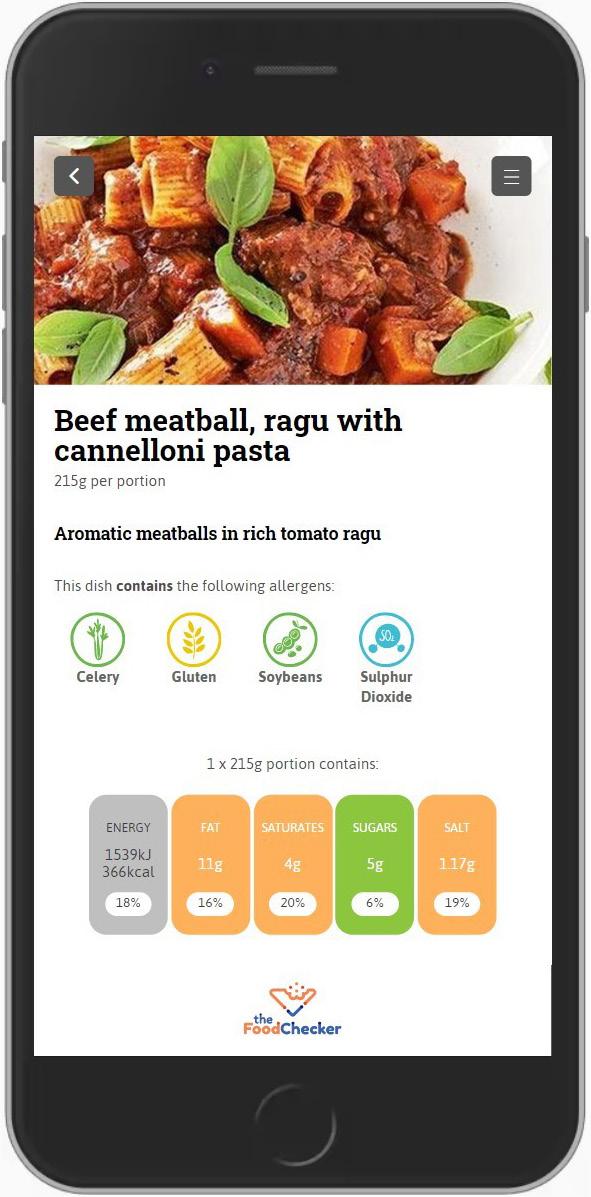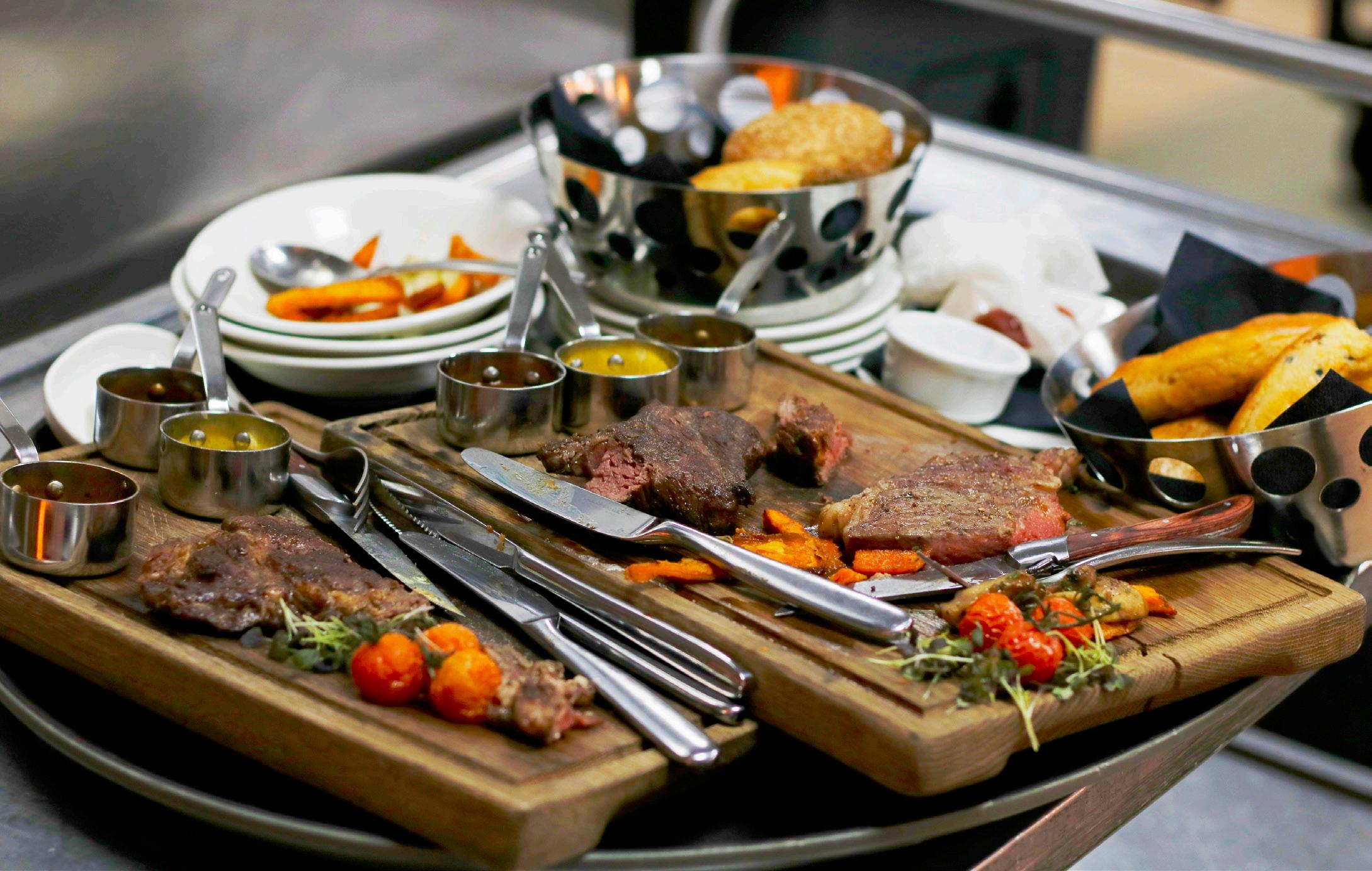
14 minute read
SYSTEMS The Food Checker
ingredient and allergen data, and most importantly how this will be passed on to your business.
Ask your supplier what verification checks and processes they have in place? How are discrepancies picked up?
2. Ingredient & allergen information
Ingredient and allergen information can be captured using third party software solutions and label printers. You will need to understand how the ingredient and allergen data is being obtained and updated. You will also need to make sure the label format is compliant with the requirements. How will the ingredient list be ordered? How will allergens be emphasised?
The labels placed on PPDS foods must be up to date with all ingredient and allergen information when put on display for the customer to select. Pre-printed labels are great if the printer breaks down but what if there is a lastminute substitution from a supplier?
Allergen data isn’t fixed and recipes for products change. Do not forget the importance of a physical label check against the data shared with you.
3. Training & responsibility
Everyone in your business must be fully informed and responsible for providing the correct allergen information. Ensure your staff receive training on the new requirements especially if you provide PPDS food.
The FSA offers a free online, self-directed Food allergy and Intolerance Training module, which can be accessed via https:// allergytraining.food.gov.uk
Five steps to get ready for Natasha’s Law
1. Plan ahead - do not leave preparations until October
2. Put processes, systems and checks in place now
3. Get in touch with your local enforcement officer to help you review and check your plans
4. Start doing trial runs of your processes and review any near misses
5. Ensure you can demonstrate due diligence throughout your allergen management
1 The Food Information Regulation 2014: https://www.legislation.gov.uk/uksi/2014/1855/pdfs/uksi_20141855_en.pdf 2 The Food Information Amendment (Amendment) (England) Regulations 2019: https://www.legislation.gov.uk/uksi/2019/1218/made 3 Food Standards Scotland (2021) Improved allergen labelling becomes Law: https://www.foodstandards.gov.scot/news-and-alerts/ improved-allergen-labelling-becomes-law-to-protect-consumers-in-scotland
Use this checklist to ensure that your catering team has a full understanding of the requirements and your processes to comply with the new legislation. What is Natasha’s Law?
Why is the new labelling legislation important?
Which foods offered are PPDS?
How many PPDS products do you offer? Are these manageable?
What must be done to comply? How will you get all the ingredient information on the labels? How will you manage label production?
Can you ensure food labels are providing accurate and reliable information in the correct format?
How will you ensure changes as a result of product substitutions are captured?
Are your team fully informed about the new allergen labelling requirements?
How will you support your customers to ask about allergens and the new labelling laws? About the author
Anna-Maria Holt is an HCPC registered dietitian, and a member of the BDA with over 15 years experience in working with caterers and food businesses. Through AH Dietetics, Anna-Maria offers a dietetic service in a freelance capacity to caterers in foodservice to help with nutrition, special diets and food allergen queries.
SYSTEMS
AN EASY WAY TO SHARE ALLERGEN AND NUTRITION INFORMATION WITH YOUR CUSTOMERS
Matt Ferris, Pi Product Manager, introduces a new way to inform customers about allergens
All food operators must provide accurate allergen information to all customers who request it and ultimately provide food that is safe for people with allergies. To help to share allergen information easily with customers we are excited to introduce our new online tool - The Food Checker - our latest addition to the Pi family!
The Food Checker has been designed to help food service operators provide a quick and easy online solution when it comes to displaying allergen and nutritional details about the food you sell.
Your customers will be able to click on recipes or use QR codes to view the allergen and nutrition details easily from their phone.
Key benefits:
▶ Quick to set up and perfectly integrates with the Pi Menu Management
Module (Piranha)
▶ Choose what information you want to display
▶ Effortless to update and manage ▶ Specifically designed for mobile use
▶ Add your own company branding and identity
▶ Generate QR codes, so it’s easy and quick for your customers to find the information they need
▶ Value added service which is available at no additional cost



Contact our Pi team to book your demonstration today. We’re sure your customers will love The Food Checker.
Contact the team on 01252 705 214 or hello@pelicanprocurement.co.uk
EXPERTISE
PUBLIC PROCUREMENT LEGISLATION UPDATE
Kim Nailor manages Pelican’s Tender Team, who handle Kim Nailor, MCIPS Tender Team Manager all aspects of formal food and non-food tendering on behalf of our clients, adhering to the latest public procurement legislation and the highest standards of professional practice.
Kim shares a quick low down on the latest changes to the public procurement legislations.
EU Procurement Legislation
EU legislation no longer applies in the UK with the exception of public procurement contracts that began before the end of transition period 31 December 2020.
However there are new regulations that are similar and, in some cases, remain unchanged and apply under UK Procurement Legislation. Some regulations are already in place with more to be reviewed over the coming months, potentially continuing up to September 2021 and beyond.
This means there may be continued changes for the foreseeable future - so watch out for further updates.
Public Contracts Regulations - Thresholds
Pelican uses government guidelines for all public sector tendering and comply with the current thresholds. The threshold for the tenders that Pelican manages remains unchanged at £189,330 and will not change until 1 January 2022, when future thresholds will be determined by the World Trade Organisation’s (WTO) Government Procurement Agreement (GPA) which the UK has been a member of since 1 January 2021.
New Contract Notice Service notices, replacing the Official Journal of the European Union (OJEU): “Find a Tender” went live on 1 January 2021.

Pelican’s procedure for posting public tenders remains the same, via an online portal: this links through to “Find a Tender” so we’ve had no disruption to our usual procedure. Procurement Policy Paper - Social Value
Our Tender Team strives to ensure that they keep up-to-date with legislation when managing tenders and recent changes to social value is a great example. Social value has become increasingly important for our clients and in September 2020 the government introduced

Procurement Policy Note 06/20 (Link: https://bit.ly/2QxTQex) – taking account of social value in the award of central government contracts.
So, from 1 January 2021 a minimum weighting of 10% is applied for social value in our tenders to ensure that it carries a heavy enough score to be a differentiating factor in our bid evaluations.

This updates the Public Services (Social Value) Act 2012 where the subject matter was just considered.
Green Paper – Transforming Public Procurement
Green Paper reforms are aimed to strengthen essential principles in public procurement. This Green Paper is intended to shape the future of public procurement in the UK. The Government’s goal is to speed up and simplify our procurement processes, put emphasis on value for money and give better opportunities to small businesses, charities and social enterprises to innovate in public service delivery.
The Green Paper talks, amongst other things of principles to be used through public procurement which Pelican already practices through their tender process:
▶ Public good - procurement should support the delivery of strategic national priorities including economic, social, ethical, environmental and public safety
▶ Value for money - procurement should enable the optimal wholelife blend of economy, efficiency and effectiveness that achieves the intended outcome of the business case
▶ Transparency - openness that underpins accountability for public money, anti-corruption, and the effectiveness of procurements
▶ Integrity - good management, prevention of misconduct, and control in order to prevent fraud and corruption
▶ Fair treatment of suppliers - decision-making by contracting authorities should be impartial and without conflict of interest
▶ Non-discrimination - decisionmaking by contracting authorities should not be discriminatory. Pelican will continue to use the open procedure for its tenders and although there will be changes to other procedures this one remains unchanged.
For the full Green Paper details go to:
https://www.gov.uk/ government/consultations/ green-paper-transformingpublic-procurement
If you need support with any issues or challenges you are currently facing, please contact our team on 01252 705214 or hello@pelicanprocurement.co.uk
EXPERTISE
HOW TO EFFECTIVELY MANAGE YOUR FOOD GROSS PROFIT
Simon Gurney, Procurement Manager
Knowing your costs and the factors which impact your profit margins is critical - this knowledge ensures that you are in control throughout each financial period, and you know where your margin is heading.
In this article, Simon Gurney, Procurement Manager at Pelican with 12 years of experience as a chef, shares his expertise on how to effectively manage food gross profit. Read on for an overview of areas often overlooked, practical tips, simple monitoring tools and opportunities to improve. Importantly, Simon also explains how Pelican’s Pi system cuts manual processes, saving you and your team a huge amount of time.
If a chef’s role was to be defined in very few words, it might be said that the job is to provide good, safe food for the establishment at which they are employed. But in recent years it has changed from not simply buying and making good food, but rather it has become about making money from the food that you buy and cook.
That difference between cost and nett selling price - gross profit - can be measured in cash margin or as a percentage margin. This is an interesting question because the old adage is that “you can’t bank a percentage”; however, many businesses target a percentage GP as the main KPI each month. It is an area worthy of deeper thought in public catering. After all, is it preferable to sell 100 steaks a week at £20.50 for £12 nett gross profit (cash) each, or to sell 50 at £25 and 76% gross profit margin – because making a percentage is the KPI?
In the first example you would make £1,200 gross profit and in the second you would make £750. However, this cash versus percentage debate is likely to be a corporate decision, so on a local and daily basis what are some key areas to help manage gross profit - and more importantly what are the practical steps to take?

First get your team onboard and tuned in to financial performance. Be aware of the impact of expenditure in your own business. As a quick rule of thumb, whatever your monthly revenue is, divide that by 100 and you will know the effect in £s and %s on your GP. As an example, if your monthly revenue is £30,000 then every £300 you spend, or indeed save, is worth one percentage point on the GP. This kind of information can be broken down into chunks which are easier to understand in the operation.
So, if you wanted to target a twopercentage point increase on the GP this month you could target your team with a £600 saving in the month, broken down into £20 a day and then even further into £7 per service. This way when you see two loaves of bread, a kg of
sausages and a tin of beans left over from breakfast you can see how that roughly adds up to that day’s £7 breakfast cost reduction. Of course, there is always some natural wastage but it’s a useful focus tool.
There are three main influences on GP - price, quantity and revenue. If you influence any of them, a change will occur to the GP of a dish.
▶ Price – the cost of the ingredients
▶ Quantity - The amount of the ingredients produced and consumed
▶ Revenue -the money received, nett of VAT, to produce the menu
In practical terms, here are five areas in which to consider taking action, working through the issues and taking practical action. Beneath each of these, we’ve added the Pelican solution, using our online management tool, Pelican Pi.
1. Deliveries
Picking and packing errors happen, so you need to have a system in place for checking and signing.
✔ Check your deliveries to make sure you receive what is on the invoice
✔ Check the prices are what is agreed
✔ Check the quantities match what you ordered to avoid ‘overdeliveries’ e.g. specified 2 x 4kg striploins and received 2 x 5kg.
How Pi can help
There are two ways that Pi can help, depending on how you like to work. Entry Level allows your team to check the electronic invoice against the paper delivery note and mark the invoice as reconciled. This means you can order the goods however you wish - but still check that you're only being invoiced for what has been received. Pelican Procurement Managers will be checking the price of the invoiced products and raising credit requests on your behalf if there is an overcharge.
Advanced features available include full Purchase to Pay functionality in which you can send your order to the supplier, then “book in” the deliveries. Any quantity difference will be highlighted, and you are able to raise a credit request.

2. Costings
Dish costings serve multiple needs apart from the obvious cost per dish. Apart from calculating margin, use the costing to engineer the recipe and achieve greater profitability.
✔ Make sure that recorded costings match what is actually going onto the plate - we call that ‘Paper to Plate’ checking.
Get your teams to benchtest the dishes coming out of their sections and make adjustments so you can amend the costings – or even review and change the ingredients.
✔ Portion control – if you have the skills and yield knowledge to prepare meat and fish in house it can be a good way to maximise margin through careful use of off-cuts and by-products. If those skills, or time, are not available then it may be preferable to buy an item cut to specification by the supplier at a nett price.
✔ Review your ingredients and work out the impact of using a less expensive alternative if it is appropriate.
How Pi can help
Pi has a fantastic menu management module called Piranha which gives you the ability to build your recipes online and share internally. You can set either a retail price, or desired GP % and as you add or amend ingredient quantities you will see both the
cost per portion and the GP being adjusted accordingly. As costs for the ingredients increase and decrease overtime (or seasonally), Piranha will automatically keep the cost per dish up to date. As recipes can be assigned to menus, categories, or tagged, you are able to run a report at anytime to check that the recipes currently in use are still achieving your desired GP - and take action if needed in order to protect your profit.
3. Wastage
Log wastage to identify trends, not to apportion blame. Wastage includes cooking mistakes, produce going bad, over-ordering, overdelivery and over-production. Don’t always think a dish is not overproduced because you can always give it to the staff because a) the cost of it might be more than the dish intended for staff and b) do you replace a staff dish with the overproduced one?
✔ Implement more efficient production. For example, if every morning after breakfast there are 20 croissants left over, then reduce the quantity you purchase, or reduce the number of parbaked ones that you prepare the evening before.
✔ Place a value to that wastage and explain the impact to your team.
For example, if wastage is £100 per day that might mean 4 points on the GP%. Break that value into chunks e.g. £30 per service so it becomes a tangible target which feels achievable.
How Pi can help
As noted, wastage is an important “cost” to any catering business which is why Pi has been developed to help! Our stock module, Pitstop, has many advanced features that can be used in their entirety so you can report on all stock movements giving a discrepancy if your EPOS tills have been integrated, or partially reducing administration but still giving more detail. For example, if using Pitstop to generate a closing stock check figure, you could also be recording wastage at each of your outlets and regularly check the total wastage across your entire estate in a single report. If checked regularly, this report can give a real insight as to where that desired GP is going and allow actions to be taken quickly to reduce this burden. For example, is the catering team purchasing too much fresh food too infrequently, rather than taking advantage of the full delivery schedule for those types of supply?
4. Theoretical margin
If the costings are correct, have been plate checked and you are in control of wastage and pilferage then what margin should you be achieving? If the menu can only achieve 70% in theory, then a target of 73% is obviously impossible!
✔ If you don’t use online systems, create a simple spreadsheet to extend dish sales per period and calculate total costs against total nett revenue both per dish and overall.





